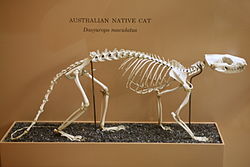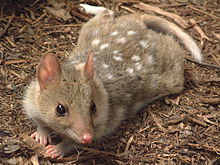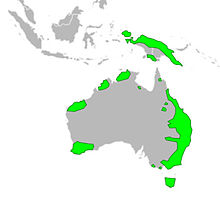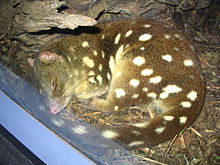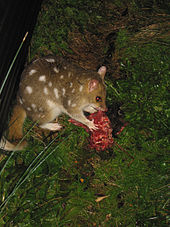- Quoll
-
Quoll 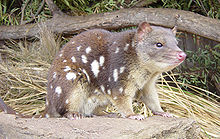
Tiger quoll (Dasyurus maculatus) Scientific classification Kingdom: Animalia Phylum: Chordata Class: Mammalia Infraclass: Marsupialia Order: Dasyuromorphia Family: Dasyuridae Subfamily: Dasyurinae Tribe: Dasyurini Genus: Dasyurus
É. Geoffroy, 1796Type species Dasyurus viverrinus
Anon., 1791
(Didelphis viverrina Shaw, 1800)Species The quoll or native cat, (genus Dasyurus), is a carnivorous marsupial native to Australia, New Guinea, and Tasmania. Quolls are primarily nocturnal and spend most of the day in their dens. There are six species of quoll. Quolls have brown or black fur, and pink noses. They vary in weight and size, from 300 grams (11 oz) to 7,000 grams (250 oz) depending on the species. Four of the species of quoll live in Australia, the other two live in New Guinea or Tasmania. Quolls are largely solitary and come together for a select few social interactions including mating, which occurs during the winter season. Females give birth to as many as 18 pups, of which only six survive to suckle on her teats and grow strong. A quoll's natural lifespan is between two and five years. They eat small mammals such as rabbits. They also eat small birds, lizards and insects. Major threats to their survival include the cane toad, feral predators, urban development, and poison baiting. Quolls are protected by strict conservation laws in an effort to increase their numbers.
Contents
Taxonomy
The genus Dasyurus comprises the following species:[1]
- Bronze quoll, Dasyurus spartacus, New Guinea
- Eastern quoll, Dasyurus viverrinus, Tasmania (formerly mainland eastern Australia)
- New Guinean quoll, Dasyurus albopunctatus, New Guinea
- Northern quoll, Dasyurus hallucatus, northern Australia
- Tiger quoll or spotted quoll, Dasyurus maculatus, eastern Australia
- Western quoll or Chuditch, Dasyurus geoffroii, western Australia
There is at least one fossil species from the Pliocene, that is D. dunmalli, described by Bartholomai in 1971. The name Dasyurus means "hairy-tail",[2] and was coined by Étienne Geoffroy Saint-Hilaire in 1796. The first species described, the tiger quoll, was originally placed in the American opossum genus Didelphis. The tribe Dasyurini to which quolls belong also includes the Tasmanian devil, the antechinus, the Kowari, and the mulgara.[1] In 1770, James Cook, otherwise known as Captain Cook, explored the east coast of Australia. While there, he collected quolls. He used the original Aboriginal name for the animals.[3]
Description
Quolls are carnivorous marsupials. Adults are between 25 and 75 centimetres (9.8 and 30 in) long, with hairy tails about 20 to 35 centimetres (14 in) long. Females have six nipples and develop a pouch during the breeding season that opens toward the tail. (with the exception of the tiger quoll, which has a true pouch), when they are rearing young. They do not have prehensile tails, but do have ridges on the pads of their feet, to walk rough ground.[4] Their coats are brown or black, with some colour variants in between. They have a bright pink nose and a long snout. Early English settlers referred to quolls as "native cats", "native polecats", or "spotted marten". Their natural lifespan is between two and five years; the larger species tend to live longer than the smaller.[5] Quolls are largely solitary animals, and are nocturnal.[6] The average weights of quolls differ greatly depending on the species. Male western and eastern quolls weigh about 1,300 grams (46 oz) and females weigh on average 900 grams (32 oz). Tiger quolls are the largest species; the males weigh about 7,000 grams (250 oz) and females 4,000 grams (140 oz). Northern quolls are the smallest; the males weigh on average 400 grams (14 oz)-900 grams (32 oz) and the females 300 grams (11 oz)-500 grams (18 oz).[7]
Habitat
Quolls are indigenous to Australia, New Guinea, and Tasmania. They live in forests and open valley land. They were once widely distributed across the three land masses, but are now found in only a few areas. Although primarily ground-dwelling they have developed secondary arboreal characteristics. Each species of quoll lives in distinct areas.[8][9][10]
- Bronze quolls are the only mammals found in the Trans Fly ecoregion in the southern part of New Guinea not also present in northern Australia. They are found in the southern part of New Guinea south of the Fly River.[8] A study conducted by the University of New South Wales suggests that bronze quolls might be related to the western quoll. The theory is that a land bridge once connected Australia and New Guinea. Around 6 to 8,000 years ago increase in water temperatures caused ice caps to melt causing a rise in sea level which effectively covered the land bridge. Many believe that the bronze quoll was "stranded" in New Guinea when the land bridge disappeared. The study, conducted in 2007, found striking similarities in the genetic makeup of the bronze and western quolls, which share 98 per cent of their DNA.[11]
- Eastern quolls are now considered extinct on the continent of Australia: the last sighting was in the 1960s. But they do inhabit much of nearby Tasmania, where they can be found in rainforests, heathland, alpine areas, and scrubs. They can be found near farms as they eat pasture food. Eastern quolls can be seen in the Mt. Field National Park.[12]
- New Guinean quolls are found throughout most of New Guinea. They tend to live at about 1,000 m elevation and can't be found in the south-western lowlands. They can also be found on Yapen Island.[9]
- Northern quolls could be found in the northern third of Australia a century ago. They tend to reside in high rocky areas and/or areas with heavy rainfall. Many northern quolls can also be found on the minor islands surrounding northern Australia. In 2003, northern quolls were translocated to Astell and Pobassoo Islands for conservation reasons.[13]
- Tiger quolls, also known as spotted quolls, live in south-eastern Australia. They tend to like rock dens more than dens made out of wood. In a study submitted by Belcher and Darrant in 2006, the habitat of tiger quolls was directly related to the amount of prey found in the area. Gullies and drainage ditches were used quite often by the quolls and ridges with rocky outcrops were used to make the rock dens that the animals enjoy.[14]
- Western quolls are restricted to the Jarrah Forest and the central and southern Australian Wheatbelt. It is believed that they once occupied 70 per cent of Australia, but because of cane toads, predators, habitat destruction and poison baiting, they cannot be found in the abundance that was once common.[10]
Behaviour
Quolls are primarily nocturnal, sleeping in hollowed out logs or rocky dens and coming out to hunt during the night, though on rare occasions they can be seen looking for prey during the day. They are mostly ground-dwelling creatures, but due to their second aboreal characteristics, it is not uncommon to see them climbing trees. Quolls mark their territory several kilometers away from their dens. Male's territory often overlaps many female's territories and male and female quolls only meet for mating.[6]. Quolls have communal "bathroom" spots, usually on an outcropping used for marking territory and social functions.These communal latrines may have up to one hundred droppings in them.[15] Quolls are solitary creatures, with contact with others mostly when mating or in social activities such as in the latrines.[16]
Diet
Quolls are mostly carnivorous; the larger species eat birds, reptiles and small mammals such as rabbits, bandicoots, echidnas, and possums. The smaller quolls primarily eat insects, birds, frogs, lizards and fruit, but every variety of quoll has been known to eat carrion. The quoll's diet is dominated by medium-sized mammals such as brush-tailed possums, rabbits and hares. The exact mix is adaptable based on reduced availability after bushfires, and can include carrion or bandicoots when food is scarce.[17] Quolls can obtain all the water they need from the food they eat which makes them quite adaptable during droughts or other periods of water shortage.[15] Quolls hunt by stalking their prey. Depending on the size of the prey, a quoll may leap or pounce onto it. Small prey is pinned down with the front paws and devoured, while they jump onto large prey, sinking their claws into the prey and latching on to the neck with their mouth. A quoll's paws and vibrissae allow them to reach into small burrows to find prey.[15]
Reproduction
Mating occurs during the winter season. Once a female quoll has been impregnated, the folds on her stomach convert into a pouch that opens at the back. The gestation period is 21 days. A baby quoll, or pup, is the size of a grain of rice. Up to 18 quolls are born to each litter, but only six survive the first two weeks. The survivors stay in their mother's pouch for eight weeks, suckling on one of the mother's six teats for milk. On the ninth week the pups venture out of the pouch and onto the mother's back where they reside for six weeks.[18] Quolls reach maturity at one year old, and have a natural lifespan of between two and five years.[19] In a study published in 2008, the pouch of a spotted-tail quoll was studied. Researchers found that pouch appearance is a reliable indicator of a quoll's reproductive status. During the follicular phase, pouches were found to be red in colour, had many secretions, and sex-hormones were very high. Post-ovulation, pouches became deep and wet. Researchers and scientists can use this information to determine where a female quoll is in her ovarian cycle. This is a non-invasive technique and will be helpful in breeding management.[20]
Threats
- Cane Toads- Cane toads were introduced into Queensland in 1935, since when their numbers grown exponentially. These poisonous toads pose a significant threat to Northern quolls, who can die rather rather quickly after consuming one. Cane toads can also shoot their venom, which can easily blind an animal. The Department of Sustainability, Environment, Water, Population and Communities has stated that cane toads are highly invasive and are major threats to the quoll's survival.[13]
- Feral predators-Feral predators such as foxes and cats are another threat to quolls. The predators not only eat quolls, but competition for food has also increased as quolls and the feral predators have similar diets. For example both quolls and feral predators catch and consume rabbits. Since the introduction of foxes, the rabbit population has dropped dramatically. Foxes have been eradicated from many of the islands off the coast of Australia in an effort to protect the quoll.[13]
- Habitat destruction-The quolls are severely suffering from urbanization, housing development, mining development, and expansion of agricultural lands. Habitats are also being destroyed by large herbivores. They trample the grass and overgrowth, making both camouflage and habitability impossible. Forest fires and weeds also contribute to habitat destruction.[13]
- Poison baitingThe poison sodium monofluroacetate is commonly used in Australia to control pests such as European rabbits, foxes, feral predators, and wild dogs such as dingoes. It is cooked into meat and then the meat is put into the wild for the animals to ingest. The poison is extremely toxic to wild dogs and other pests, but considerably less toxic to quolls. A main factor in how the poison will affect a quoll is in the size. Bigger quolls will suffer no ill effects from eating one piece of prepared meat containing sodium monofluroacetate, but will suffer if they eat more than one within a short period of time. One piece of meat may be lethal to female and juvenile quolls. Since quolls are carnivores and will readily consume any meat left out, they are at high risk from the poison. The meat is supposed to be buried at least eight centimeters under the ground, but have been found under minimal dirt which quolls can dig around to get to the meat. The poisoning is currently being investigated, as many believe that the number of quolls protected from predators by the bait is much more than those who ingest the poison and die.[13][21]
Conservation efforts
Since 1770, all Australian quolls have declined in number owing to habitat loss caused by urbanization. Quolls are threatened by toxic cane toads, but a University of Sydney project revealed in 2010 is teaching them to avoid eating the invasive amphibians.[22] In 2008 the Northern Territory Wildlife Park in Australia recorded their first litter of quoll pups in the park. The quolls bred well in captivity, with over fifteen litters in the 2008 breeding season alone.[23]
In late October 2011, a litter of five tiger quoll pups was born at Wild Life Sydney in Darling Harbour, Australia. The pups were born to inexperienced parents, both just one year old. The reason being that male quolls can easily kill a female if they do not want to mate. Four of the quoll pups will be sent to other zoos or wildlife parks across Australia but one-whom the researchers named Nelson, will stay at the centre to become an "ambassador for all quolls".[24]
Fox control programs have benefited the western quoll. The Department of Environment and Conservation (Western Australia) monitors western quoll populations in the Jarrah Forest as part of its faunal management programs, as well as ongoing research into fox control, timber harvesting, and prescribed burning. The Perth Zoo has been monitoring a successful captive breeding program since 1989. They have successfully bred more than sixty western quolls; most being translocated to Julimar Conservation Park, with proposals to translocate to Wheatbelt (Western Australia) reserves and Shark Bay.[10]
The bronze quoll is kept in Wasur National Park and Tonda Wildlife Management Area. More research on distribution and threats is needed for further conservation.[8]
References
- ^ a b (Groves 2005, pp. 24–25)
- ^ (Strahan 2008, pp. 62–64)
- ^ "Australian Threatened Species, Tiger Quoll, Spotted-tailed Quoll or Spot-tailed Quoll, Dasyurus maculatus". Australian Government: Department of Sustainability, Environment, Water, Population, and Communities. 3 June 2011. http://www.environment.gov.au/biodiversity/threatened/publications/pubs/tiger-spotted-quoll.pdf. Retrieved 25 October 2011.
- ^ (McCay 1999, p. [page needed])
- ^ "Quolls of Australia". Australian Government:Department of Environment and Heritage.
- ^ a b York Fei Leung. "Dasyurus geoffroi i". University of Michigan Museum of Zoology. http://http://animaldiversity.ummz.umich.edu/site/accounts/information/Dasyurus_geoffroii.html. Retrieved 31 October 2011.
- ^ "Quolls of Australia". Australian Government: Department of the Environment and Heritage. 2003. http://www.environment.gov.au/biodiversity/threatened/publications/quolls2003.html. Retrieved 2 November 2011.
- ^ a b c "Dasyurus spartacus". IUCN. http://www.iucnredlist.org/apps/redlist/details/6301/0. Retrieved 20 October 2011.
- ^ a b "Dasyurus albopunctatus". IUCN Red List of Threatened Species. http://www.iucnredlist.org/apps/redlist/details/6299/0. Retrieved 20 October 2011.
- ^ a b c "Dasyurus geoffroii". IUCN Red List of Threatened Species. http://www.iucnredlist.org/apps/redlist/details/6294/0. Retrieved 20 October 2011.
- ^ "New Guinea's bronze quoll could be a long lost Aussie". UNSW. https://www.unsw.edu.au/news/pad/articles/2007/jun/Bronzed_quoll.html. Retrieved 20 October 2011.
- ^ "Eastern Quoll, Dasyurus viverrinus". Parks and Wildlife Service, Tasmania. http://www.parks.tas.gov.au/index.aspx?base=4774. Retrieved 20 October 2011.
- ^ a b c d e Hill, B. M.; Ward, S. J.. "National Recovery Plan for the Northern Quoll Dasyurus hallucatus". Department of Natural Resources, Environment, The Arts and Sport, Darwin. pp. 1,3,6,7. http://www.environment.gov.au/biodiversity/threatened/publications/recovery/pubs/northern-quoll.pdf. Retrieved 20 October 2011.
- ^ Belcher; Darrant (2006). "Habitat Use by Tiger Quoll (Dasyurus maculatus) (Marsupialia: Dasyuridae)in south-eastern Australia". Journal of Zoology (ZSL) 269 (2): 183–190. doi:10.1111/j.1469-7998.2006.00056.x. http://onlinelibrary.wiley.com/doi/10.1111/j.1469-7998.2006.00056.x/abstract. Retrieved 20 October 2011.
- ^ a b c Jones, Menna E.; Rose, Robert K.; Burnett, Scott (2001). "Dasyurus maculatus". Mammalian Species (American Society of Mammalogists) (676): 1-9. http://www.science.smith.edu/departments/Biology/VHAYSSEN/msi/pdf/676_Dasyurus_maculatus.pdf. Retrieved 25 October 2011.}
- ^ "Native Plants and Animals". Department of Primary Industries, Parks, Water and Environment. http://www.dpiw.tas.gov.au/inter.nsf/WebPages/BHAN-5373YJ?open. Retrieved 1 November 2011.}
- ^ Dawson, J. P.; Claridge, A. W.; Triggs, B.; Paull, D. J. (2007). "Diet of a native carnivore, the spotted-tailed quoll (Dasyurus maculatus), before and after an intense wildfire". Wildlife Research 34 (5): 342. doi:10.1071/WR05101.
- ^ "Parks and Wildlife Service-Spotted-tail Quoll". Parks and Wildlife Service Tasmania. http://www.parks.tas.gov.au/?base=4807. Retrieved 19 October 2011.
- ^ "Quolls of Australia". Government of Australia. 3 June 2011. http://www.environment.gov.au/biodiversity/threatened/publications/quolls2004.html. Retrieved 6 October 2011.
- ^ Hesterman, H.; Jones, S. M.; Schwarzenberger, F. (2008). "Pouch appearance is a reliable indicator of the reproductive status in the Tasmanian devil and the spotted-tailed quoll". Journal of Zoology (The Zoological Society of London) 275 (2): 130–138. doi:10.1111/j.1469-7998.2008.00419.x. http://onlinelibrary.wiley.com/doi/10.1111/j.1469-7998.2008.00419.x/abstract;jsessionid=BC0332216D832F6A4505431468DBC6C2.d02t02. Retrieved 26 October 2011.}
- ^ "Draft revised Tiger Quoll Action Statement". Otway Ranges Environment Network. June 2001. http://www.oren.org.au/issues/endspp/Tigerquoll/DraftTQAS.htm#5.
- ^ "Taste training for northern quolls". Australian Geographic. http://www.australiangeographic.com.au/journal/quolls-in-danger.htm. Retrieved 15 April 2010.
- ^ "Endangered Quolls breeding well in captivity in Darwin". Wildlife Extra. http://www.wildlifeextra.com/go/news/quoll-192.html#cr. Retrieved 2 November 2011.
- ^ Liz T. Williams (October 26 2011). "Baby quolls a boost for breeding program". Australian Geographic. http://www.australiangeographic.com.au/journal/litter-of-baby-quolls-a-boost-for-breeding-program.htm. Retrieved 2 November 2011.
Bibliography
- Groves, C.; Wilson, D.E.; Reeder, D.M. (2005). Mammal Species of the World. John Hopkins University Press. pp. 24–25. ISBN 0-801-88221-4.
- McCay, George (1999). Mammals. Fog City Press.
- Strahan, Ronald; Steve van Dyck (2008). The Mammals of Australia. New Holland. pp. 62–64. ISBN 9781877069253.
Categories:- Dasyuromorphs
- Words and phrases of Australian Aboriginal origin
- Marsupials of Australia
- Mammals of New Guinea
Wikimedia Foundation. 2010.

